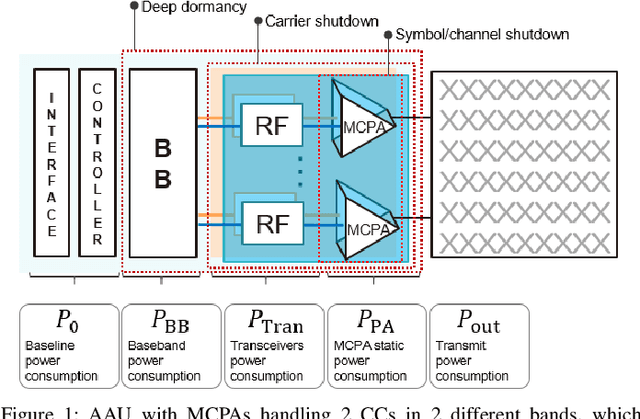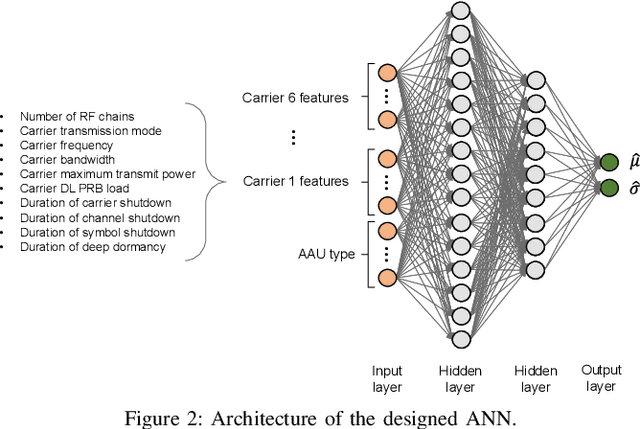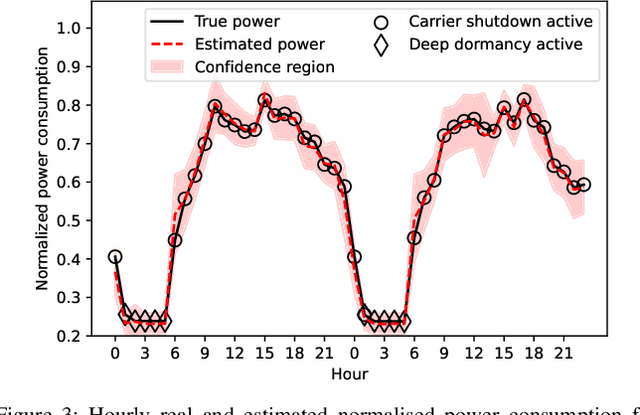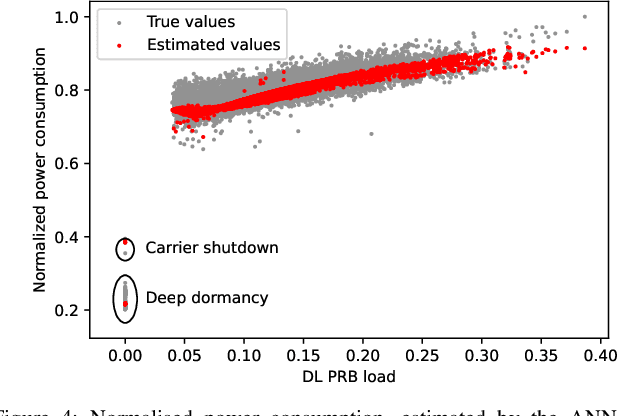David Lopez-Perez
CNN Autoencoder Resizer: A Power-Efficient LoS/NLoS Detector in MIMO-enabled UAV Networks
May 26, 2024Abstract:Optimizing the design, performance, and resource efficiency of wireless networks (WNs) necessitates the ability to discern Line of Sight (LoS) and Non-Line of Sight (NLoS) scenarios across diverse applications and environments. Unmanned Aerial Vehicles (UAVs) exhibit significant potential in this regard due to their rapid mobility, aerial capabilities, and payload characteristics. Particularly, UAVs can serve as vital non-terrestrial base stations (NTBS) in the event of terrestrial base station (TBS) failures or downtime. In this paper, we propose CNN autoencoder resizer (CAR) as a framework that improves the accuracy of LoS/NLoS detection without demanding extra power consumption. Our proposed method increases the mean accuracy of detecting LoS/NLoS signals from 66% to 86%, while maintaining consistent power consumption levels. In addition, the resolution provided by CAR shows that it can be employed as a preprocessing tool in other methods to enhance the quality of signals.
Energy-Efficient Sleep Mode Optimization of 5G mmWave Networks Using Deep Contextual MAB
May 15, 2024Abstract:Millimeter-wave (mmWave) networks, integral to 5G communication, offer a vast spectrum that addresses the issue of spectrum scarcity and enhances peak rate and capacity. However, their dense deployment, necessary to counteract propagation losses, leads to high power consumption. An effective strategy to reduce this energy consumption in mobile networks is the sleep mode optimization (SMO) of base stations (BSs). In this paper, we propose a novel SMO approach for mmWave BSs in a 3D urban environment. This approach, which incorporates a neural network (NN) based contextual multi-armed bandit (C-MAB) with an epsilon decay algorithm, accommodates the dynamic and diverse traffic of user equipment (UE) by clustering the UEs in their respective tracking areas (TAs). Our strategy includes beamforming, which helps reduce energy consumption from the UE side, while SMO minimizes energy use from the BS perspective. We extended our investigation to include Random, Epsilon Greedy, Upper Confidence Bound (UCB), and Load Based sleep mode (SM) strategies. We compared the performance of our proposed C-MAB based SM algorithm with those of All On and other alternative approaches. Simulation results show that our proposed method outperforms all other SM strategies in terms of the $10^{th}$ percentile of user rate and average throughput while demonstrating comparable average throughput to the All On approach. Importantly, it outperforms all approaches in terms of energy efficiency (EE).
Designing Cellular Networks for UAV Corridors via Bayesian Optimization
Aug 09, 2023



Abstract:As traditional cellular base stations (BSs) are optimized for 2D ground service, providing 3D connectivity to uncrewed aerial vehicles (UAVs) requires re-engineering of the existing infrastructure. In this paper, we propose a new methodology for designing cellular networks that cater for both ground users and UAV corridors based on Bayesian optimization. We present a case study in which we maximize the signal-to-interference-plus-noise ratio (SINR) for both populations of users by optimizing the electrical antenna tilts and the transmit power employed at each BS. Our proposed optimized network significantly boosts the UAV performance, with a 23.4dB gain in mean SINR compared to an all-downtilt, full-power baseline. At the same time, this optimal tradeoff nearly preserves the performance on the ground, even attaining a gain of 1.3dB in mean SINR with respect to said baseline. Thanks to its ability to optimize black-box stochastic functions, the proposed framework is amenable to maximize any desired function of the SINR or even the capacity per area.
Power Consumption Modeling of 5G Multi-Carrier Base Stations: A Machine Learning Approach
Dec 08, 2022



Abstract:The fifth generation of the Radio Access Network (RAN) has brought new services, technologies, and paradigms with the corresponding societal benefits. However, the energy consumption of 5G networks is today a concern. In recent years, the design of new methods for decreasing the RAN power consumption has attracted interest from both the research community and standardization bodies, and many energy savings solutions have been proposed. However, there is still a need to understand the power consumption behavior of state-ofthe-art base station architectures, such as multi-carrier active antenna units (AAUs), as well as the impact of different network parameters. In this paper, we present a power consumption model for 5G AAUs based on artificial neural networks. We demonstrate that this model achieves good estimation performance, and it is able to capture the benefits of energy saving when dealing with the complexity of multi-carrier base stations architectures. Importantly, multiple experiments are carried out to show the advantage of designing a general model able to capture the power consumption behaviors of different types of AAUs. Finally, we provide an analysis of the model scalability and the training data requirements.
Machine Learning and Analytical Power Consumption Models for 5G Base Stations
Sep 23, 2022



Abstract:The energy consumption of the fifth generation(5G) of mobile networks is one of the major concerns of the telecom industry. However, there is not currently an accurate and tractable approach to evaluate 5G base stations (BSs) power consumption. In this article, we propose a novel model for a realistic characterisation of the power consumption of 5G multi-carrier BSs, which builds on a large data collection campaign. At first, we define a machine learning architecture that allows modelling multiple 5G BS products. Then, we exploit the knowledge gathered by this framework to derive a realistic and analytically tractable power consumption model, which can help driving both theoretical analyses as well as feature standardisation, development and optimisation frameworks. Notably, we demonstrate that such model has high precision, and it is able of capturing the benefits of energy saving mechanisms. We believe this analytical model represents a fundamental tool for understanding 5G BSs power consumption, and accurately optimising the network energy efficiency.
UAV Communications in Integrated Terrestrial and Non-terrestrial Networks
Aug 04, 2022



Abstract:With growing interest in integrating terrestrial networks (TNs) and non-terrestrial networks (NTNs) to connect the unconnected, a key question is whether this new paradigm could also be opportunistically exploited to augment service in urban areas. We assess this possibility in the context of an integrated TN-NTN, comprising a ground cellular deployment paired with a Low Earth Orbit (LEO) satellite constellation, providing sub-6 GHz connectivity to an urban area populated by ground users (GUEs) and uncrewed aerial vehicles (UAVs). Our study reveals that offloading UAV traffic to the NTN segment drastically reduces the downlink outage of UAVs from 70% to nearly zero, also boosting their uplink signal quality as long as the LEO satellite constellation is sufficiently dense to guarantee a minimum elevation angle. Offloading UAVs to the NTN also benefits coexisting GUEs, preventing uplink outages of around 12% that GUEs would otherwise incur. Despite the limited bandwidth available below 6 GHz, NTN-offloaded UAVs meet command and control rate requirements even across an area the size of Barcelona with as many as one active UAV per cell. Smaller UAV populations yield proportionally higher rates, potentially enabling aerial broadband applications.
Integrating Terrestrial and Non-terrestrial Networks: 3D Opportunities and Challenges
Jul 21, 2022



Abstract:Integrating terrestrial and non-terrestrial networks has the potential of connecting the unconnected and enhancing the user experience for the already-connected, with technological and societal implications of the greatest long-term significance. A convergence of ground, air, and space wireless communications also represents a formidable endeavor for the mobile and satellite communications industries alike, as it entails defining and intelligently orchestrating a new 3D wireless network architecture. In this article, we present the key opportunities and challenges arising from this (r)evolution by presenting some of its disruptive use-cases and key building blocks, reviewing the relevant standardization activities, and pointing to open research problems. By considering two multi-operator paradigms, we also showcase how terrestrial networks could be efficiently re-engineered to cater for aerial services, or opportunistically complemented by non-terrestrial infrastructure to augment their current capabilities.
 Add to Chrome
Add to Chrome Add to Firefox
Add to Firefox Add to Edge
Add to Edge